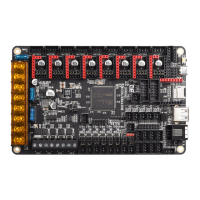Produced by BIGTREETECH
Page 11 of 25
3 STEPPER DRIVER OPERATIONAL MODES
Note: The octopus packs a ton of features which means there are many
connectors and components. In order to keep the board size to a minimum we
placed the stepper sockets close to each other. This means that drivers will
have a snug fit.
3.1 STEP/DIR MODE
If you are using drivers that do not support configuration over a serial port then you will
need to operate them in step/dir mode and set the jumpers beneath the stepper driver
according to the microstepping you desire.
Each driver will have its own microstepping table so we do not attempt to speak on behalf
of the driver manufacturer in our guide. Please consult the datasheet of your driver to
determine what signals need to be applied to the microstepping configuration pins in order
to achieve the microstepping you desire.
Nevertheless, below you will see a figure which will help you to identify which jumpers
correspond to the pins that your drivers will use to configure microstepping and we have
additionally included a section in appendix A1 which contains the microstepping tables for
some of the most common drivers. This should be viewed as a convenience to the user and
we still recommend that you consult the datasheet of your driver manufacturer.
In the above image the red rectangle isolates one group of driver pins. For the purpose of
running the drivers in step/dir mode the pinout can be described as per the table below
(note that this is not the actual pinout but rather a simplification for step/dir mode).
Connecting jumpers between the upper two rows will set the middle pin (MS) to 0V.
Connecting jumpers between the lower two rows will set the middle pin (MS) to 3.3V except
for the jumpers in the first column where it will connect SLP and RST.

